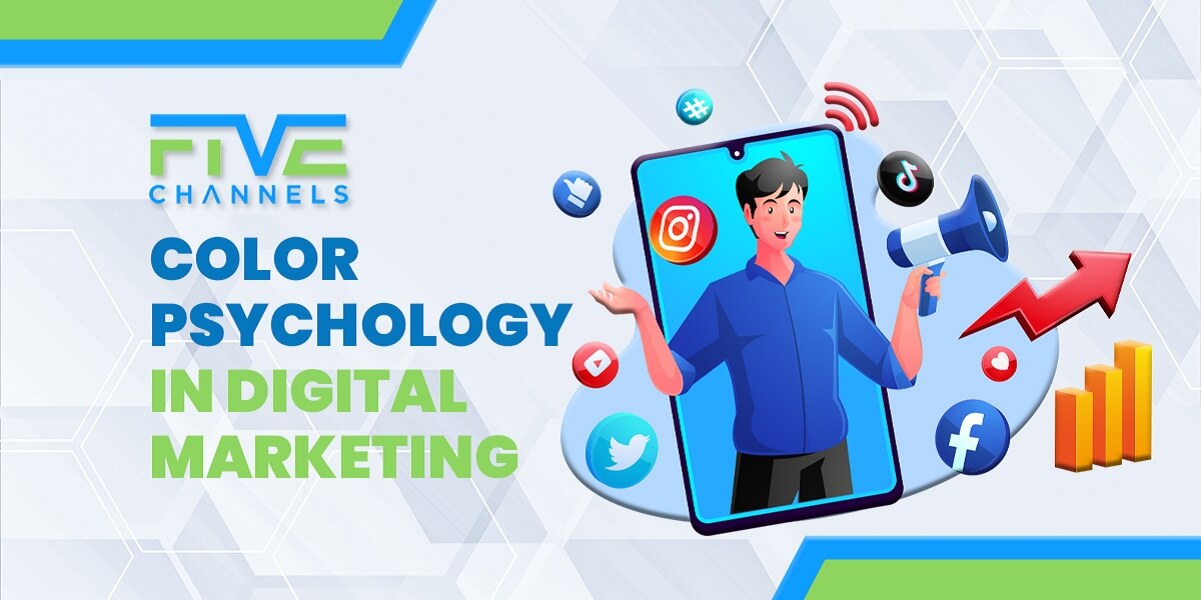Did you know that green represents health and stress relief? What about the fact that yellow is the first color that infants see because it’s the easiest color for their eyes to detect? Have you heard that purple invokes mystery and innovation?
If it’s your first time hearing about these rules of color psychology. You’re not the only one. Many people don’t understand how much colors affect them.
However, you’ll begin to see the patterns once you learn more, and you’ll see why companies use color marketing to invoke feelings in their consumers.
Discover more about what colors have to offer you and your company’s marketing plan.

What is Color Psychology?
Color psychology is the study of how colors affect human perceptions and behaviors. Experts on color psychology can use their knowledge in several different applications, including marketing and branding.
You may notice that certain industries abide by similar color schemes. It’s no mistake that McDonald’s, Burger King, Wendy’s, Pizza Hut, and similar eating establishments use yellow in their color scheme.
It’s all about the psychology behind the colors.
Whether you know it or not, the colors that these brands are using affect whether or not you buy from them. A difference in the color scheme could lead to a difference in sales when these colors affect consumers on a large scale.
If you don’t believe us, consider the research. 90% of snap judgments that consumers make about products are based on their color alone.
How Does Color Psychology in Marketing Work?
In order to learn more about how color affects us, psychologists and marketing researchers have conducted study after study. From their findings, they’ve found a few general claims in relation to popular colors:
- Yellow represents optimism, clarity, and warmth
- Orange represents friendliness, cheerfulness, and confidence
- Red represents excitement, youthfulness, and boldness
- Purple represents creativity, imagination, and wisdom
- Blue represents trust, dependability, and strength
- Green represents peacefulness, growth, and health
- Grey represents balance, neutrality, and calmness
You might not have realized it before, but now that you’re in on the psychology behind these colors, you’ll likely start to notice a shift in your thinking. You’ll notice how the orange Nickelodeon logo excites you or the blue JP Morgan logo makes you feel safe.
These colors are also meant to create a first impression (even if we don’t realize that that’s what’s happening). The right collection of colors can leave a lasting impression on your visitors.
It could also draw them into your website even more. Thus, you could make more sales or gain a new follower just because of your attractive color scheme.
Our brains are wired to react to colors like this, but it’s not all as perfect as it may seem.
When Should I Use Color Psychology in Marketing?
Colors have the ability to affect consumers at different stages in the marketing and sales cycles. No matter where you are in the cycle, or what you’re planning for your customers, it’s important to include color. With anything, color can define a consumer’s mood and influence their responses.
Here are some of the digital marketing elements that you should use your color psychology knowledge with:
- Logos
- Branding documents
- Landing page
- Menu bar
- Email marketing
- Social media posts
- Videos
- Product designs
- Cover photos
You should also make sure that your branding is consistent across all forums. Whether you’re posting on Instagram or putting up a new article, the color scheme should be somewhat similar. Your customers should be able to know that it’s your business based on the colors that you use.
How Should I Use Color in Marketing?
When it comes to how to use color in marketing, it’s important to keep everything we’ve discussed in mind. One color isn’t going to change your entire business, but it could revolutionize your ability to bring in potential customers.
Once the color has helped with the initial grab, then you can continue giving the amazing service that you pride yourself in.
Unfortunately, there isn’t a clear-cut way to decide which color(s) you should use for your brand. It’s likely that you want your customers to perceive you as optimistic, friendly, exciting, creative, trustworthy, peaceful, and balanced.
However, unless you’re willing to slap a rainbow on the front of your logo, it’s unlikely that you want every color seeping through your company name. So, you have to decide for certain what kind of colors you want.
How to Find the Right Color for Your Brand
The first thing that you have to think about is appropriateness. Consumers care about how the color relates to your brand more than how the color relates to their personal feelings.
In fact, a study found that the color and its appropriateness for the brand is what matters the most. It’s not about choosing the most popular color. It’s about choosing the right color for your industry and your products/services.
So, you should narrow down your choices to a few colors that you think would represent your products/services well. It may help to look at what other companies in your industry are doing. You may notice a theme in the color schemes across your competitors’ logos.
Still, you don’t have to pick the winner just yet because there are a few other things to take into consideration.
Next, you want to think about the overall personality of your brand. Since color does influence a consumer’s thoughts about your brand, it’s important to prioritize this as you’re choosing the right color(s) for your logo.
In particular, you should consider the five dimensions of brand personality:
- Sincerity
- Excitement
- Competence
- Sophistication
- Ruggedness
Many businesses identify with more than one of these dimensions, but, in most cases, businesses will fall primarily under one dimension. So, you should think about how you want your customers to think about your business. Then, you can decide how you want to portray your business via logo color(s).
Consider Your Audience
When you’re choosing the right color(s) for your logo, you have to consider your company’s target audience. Remember, the way that consumers receive information about a particular color depends on their experiences with that color in the past.
So, you have to take this into account when you’re choosing your color(s). This means that you have to account for how your target audience would feel about the color(s) that you’re choosing, and don’t generalize.
If your target audience is female, you might assume that they like softer colors. However, many women have the opposite feeling. Because they are associated regularly with these colors, many grow to resent them.
You have to consider whether your target audience is composed of women who prefer soft colors, women who resent them, or another group of people entirely. This is a great way to leverage consumer psychology.
This strategy requires a lot of insight into who exactly your target audience is, but if you haven’t dived deep into this yet, it’s a perfect time to do it. The data that you gather is important for all branches of your business, especially marketing and sales.
In the end, you want to stand out. Don’t be afraid to break norms, expectations, and stereotypes. In fact, your business may be more popular for doing so.
What Colors Work for Marketing?
It’s important to note that you could choose any color or group of colors that you want. There are no limitations, but there are a few unspoken rules when it comes to narrowing down your color choices.
Consider Different Palette Types
Color isn’t linear. Choosing one color does not mean that you have to choose its complement or a similar shade. There are no absolutes that you have to stick to.
In fact, we recommend trying out ideas with the three different ways to use color:
- Complementation
- Contrast
- Vibrancy
Complementation refers to the pattern of choosing a color on the opposite side of the color wheel. Blue complements orange, purple complements yellow, and red complements green.
Opting for complementary colors makes it easier for your audience to see what they’re doing. If you’re choosing colors that are close to one another on the color wheel, your audience may be straining to see differences across your marketing materials.
Contrast refers to a switch in the normal color scheme. Usually, marketers will use dark text on a light background. With contrasting materials, they’ll use light text on a dark background.
This can help reduce eye strain and make it easier to differentiate between different headings.
Vibrancy refers to using bright colors in your design. It makes the reader feel more energetic.
For this color scheme, you’re going to want to use colors that brighten up your materials. You can choose pastel or neon but be careful not to strain your audiences’ eyes. Too much color at once can give them a headache.
Don’t Copy the Competition
Earlier, we asked you to consider the kinds of colors that your competitors are using, but we should be clear that you don’t want to be like your competitors. In fact, standing out could be better.
If you’ve got the same yellow logo that all other restaurants have, you might be missing out on the ability to look different. We associated McDonald’s, Burger King, and Wendy’s with one another because of their similar logos.
If you want to stand out, you have to be different, and your logo matters.
If you find that everyone else in your industry is using a particular color, you may want to steer clear of it. While it could be popular in your industry, you want to appear different than everyone else out there. A simple color change can do the trick in consumers’ minds.
Include Colorblind Consumers
It might not be the first thing on your mind, but it’s important to think about the consumers that are colorblind. They should be able to enjoy your company’s logo too.
In fact, Facebook’s logo is blue because Mark Zuckerberg is red-green colorblind.
Mostly, individuals with color-blindness have trouble differentiating between dichromatic colors. This means that they have trouble distinguishing shades from one another.
To help these people distinguish colors, you may want to consider a trinomial color scheme. These consist of several solid colors rather than several shades of the same colors. So, people with color-blindness can differentiate the colors without having to strain.
The Problem with Color Psychology in Marketing
Like any other science, color psychology is flawed. There’s no perfect way to tell how a consumer may react to any given color.
Some customers may associate red with happiness and orange with calmness. Others may associate yellow with health and green with trust.
There’s no telling what someone’s perception might be. In fact, it’s hard for us to know our own internal thought unless we sit down and think them through.
Color psychology is impulsive. Companies aren’t relying on the fact that you’ll take the time to think about how their logo makes you feel. Rather, they’ll hope that you rely on that impulsivity to guide your thoughts about the company.
This isn’t malicious. It’s business.
Companies are trying to use basic human senses to establish a relationship with their customers early on.
However, it’s important that businesses don’t rely on their coloring to get them by. A trustworthy blue logo isn’t going to convince an unhappy customer that they should come back after a bad experience. The company has to do that themselves, but the logo can help get the consumer’s foot in the door.
Color Psychology via Digital Marketing
Congratulations! After getting through all that, you can officially call yourself an expert in color psychology. You know the ins and outs of choosing the right color and how those colors can affect your visitors.
Now, it’s time to apply your knowledge. We recommend starting with our free digital marketing review. We can help you get a full look at just how well (or not well) your current strategy is working.
From there, we can work on developing a new, more effective strategy that includes the proper colors for your business.
Owner and Chief Marketing Officer, Jason Hall, and his team specialize in creating brand awareness / traffic and lead generation / marketing funnel and conversion optimization, while utilizing the appropriate marketing channels available within your industry. With diverse clients throughout the world, Jason's team is well connected within many industries to assist with your marketing strategies. With no long term contracts and various levels of service, Jason's team will increase the quality of your online traffic, leads, and sales.
About the author...
Located in the heart of the Emerald Coast - Destin, FL, founder and Chief Marketing Officer, Jason Hall, and his team specialize in creating brand awareness / traffic and lead generation / marketing funnel and conversion optimization / and PR campaigns, while utilizing the appropriate marketing channels available within your industry.
With diverse clients throughout the world, Jason's team is well connected within many industries to assist with your marketing strategies. With no long term contracts and various levels of service, Jason's team will increase the quality of your online traffic, leads, and sales.









